Microbiology: Staphylococcus Aureus Prevalence and Resistance
VerifiedAdded on 2023/04/23
|10
|3141
|396
Report
AI Summary
This microbiology report focuses on Staphylococcus aureus, a gram-positive bacterium known for colonizing human skin and causing various infections. The study investigates the prevalence and characteristics of S. aureus strains, including Methicillin-resistant S. aureus (MRSA), within a university setting. Biochemical tests, such as coagulase agglutination assays, and molecular techniques, including PCR, were employed to identify and characterize the isolates. The report details the antibiotic resistance profiles of different strains, highlighting the role of the mecA gene in methicillin resistance. Furthermore, the presence of the toxic shock syndrome toxin (TSST) gene was investigated. The findings indicate the continued presence of diverse S. aureus isolates within the university environment, emphasizing the need for ongoing monitoring and control measures. The report includes tables and figures presenting the results of the biochemical tests, PCR analysis, and antibiotic susceptibility testing, providing a comprehensive overview of the study's findings.

Running head: MICROBIOLOGY
Topic: MICROBIOLOGY
Name of the Student:
Name of the University:
Authors Note:
Topic: MICROBIOLOGY
Name of the Student:
Name of the University:
Authors Note:
Paraphrase This Document
Need a fresh take? Get an instant paraphrase of this document with our AI Paraphraser
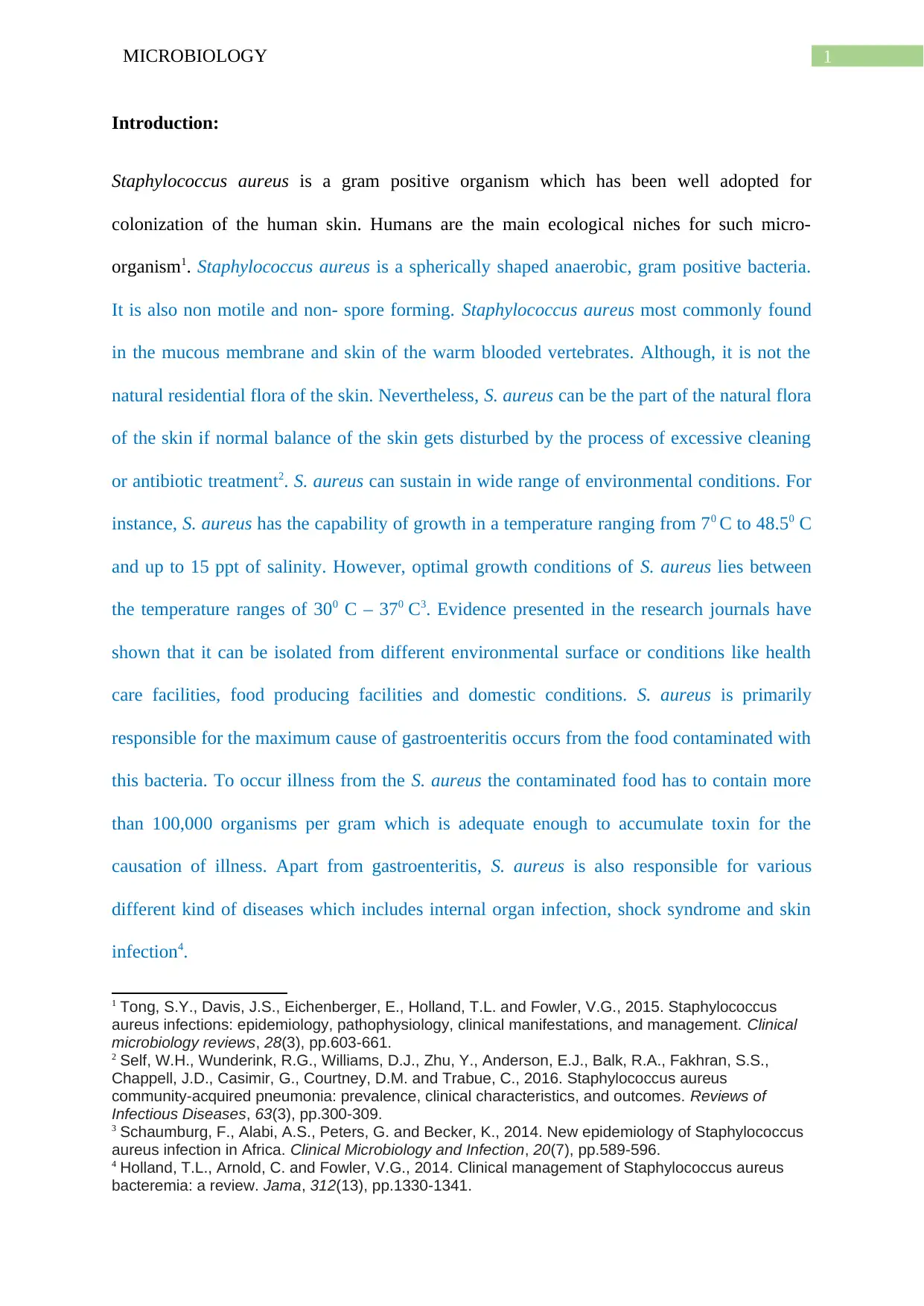
1MICROBIOLOGY
Introduction:
Staphylococcus aureus is a gram positive organism which has been well adopted for
colonization of the human skin. Humans are the main ecological niches for such micro-
organism1. Staphylococcus aureus is a spherically shaped anaerobic, gram positive bacteria.
It is also non motile and non- spore forming. Staphylococcus aureus most commonly found
in the mucous membrane and skin of the warm blooded vertebrates. Although, it is not the
natural residential flora of the skin. Nevertheless, S. aureus can be the part of the natural flora
of the skin if normal balance of the skin gets disturbed by the process of excessive cleaning
or antibiotic treatment2. S. aureus can sustain in wide range of environmental conditions. For
instance, S. aureus has the capability of growth in a temperature ranging from 70 C to 48.50 C
and up to 15 ppt of salinity. However, optimal growth conditions of S. aureus lies between
the temperature ranges of 300 C – 370 C3. Evidence presented in the research journals have
shown that it can be isolated from different environmental surface or conditions like health
care facilities, food producing facilities and domestic conditions. S. aureus is primarily
responsible for the maximum cause of gastroenteritis occurs from the food contaminated with
this bacteria. To occur illness from the S. aureus the contaminated food has to contain more
than 100,000 organisms per gram which is adequate enough to accumulate toxin for the
causation of illness. Apart from gastroenteritis, S. aureus is also responsible for various
different kind of diseases which includes internal organ infection, shock syndrome and skin
infection4.
1 Tong, S.Y., Davis, J.S., Eichenberger, E., Holland, T.L. and Fowler, V.G., 2015. Staphylococcus
aureus infections: epidemiology, pathophysiology, clinical manifestations, and management. Clinical
microbiology reviews, 28(3), pp.603-661.
2 Self, W.H., Wunderink, R.G., Williams, D.J., Zhu, Y., Anderson, E.J., Balk, R.A., Fakhran, S.S.,
Chappell, J.D., Casimir, G., Courtney, D.M. and Trabue, C., 2016. Staphylococcus aureus
community-acquired pneumonia: prevalence, clinical characteristics, and outcomes. Reviews of
Infectious Diseases, 63(3), pp.300-309.
3 Schaumburg, F., Alabi, A.S., Peters, G. and Becker, K., 2014. New epidemiology of Staphylococcus
aureus infection in Africa. Clinical Microbiology and Infection, 20(7), pp.589-596.
4 Holland, T.L., Arnold, C. and Fowler, V.G., 2014. Clinical management of Staphylococcus aureus
bacteremia: a review. Jama, 312(13), pp.1330-1341.
Introduction:
Staphylococcus aureus is a gram positive organism which has been well adopted for
colonization of the human skin. Humans are the main ecological niches for such micro-
organism1. Staphylococcus aureus is a spherically shaped anaerobic, gram positive bacteria.
It is also non motile and non- spore forming. Staphylococcus aureus most commonly found
in the mucous membrane and skin of the warm blooded vertebrates. Although, it is not the
natural residential flora of the skin. Nevertheless, S. aureus can be the part of the natural flora
of the skin if normal balance of the skin gets disturbed by the process of excessive cleaning
or antibiotic treatment2. S. aureus can sustain in wide range of environmental conditions. For
instance, S. aureus has the capability of growth in a temperature ranging from 70 C to 48.50 C
and up to 15 ppt of salinity. However, optimal growth conditions of S. aureus lies between
the temperature ranges of 300 C – 370 C3. Evidence presented in the research journals have
shown that it can be isolated from different environmental surface or conditions like health
care facilities, food producing facilities and domestic conditions. S. aureus is primarily
responsible for the maximum cause of gastroenteritis occurs from the food contaminated with
this bacteria. To occur illness from the S. aureus the contaminated food has to contain more
than 100,000 organisms per gram which is adequate enough to accumulate toxin for the
causation of illness. Apart from gastroenteritis, S. aureus is also responsible for various
different kind of diseases which includes internal organ infection, shock syndrome and skin
infection4.
1 Tong, S.Y., Davis, J.S., Eichenberger, E., Holland, T.L. and Fowler, V.G., 2015. Staphylococcus
aureus infections: epidemiology, pathophysiology, clinical manifestations, and management. Clinical
microbiology reviews, 28(3), pp.603-661.
2 Self, W.H., Wunderink, R.G., Williams, D.J., Zhu, Y., Anderson, E.J., Balk, R.A., Fakhran, S.S.,
Chappell, J.D., Casimir, G., Courtney, D.M. and Trabue, C., 2016. Staphylococcus aureus
community-acquired pneumonia: prevalence, clinical characteristics, and outcomes. Reviews of
Infectious Diseases, 63(3), pp.300-309.
3 Schaumburg, F., Alabi, A.S., Peters, G. and Becker, K., 2014. New epidemiology of Staphylococcus
aureus infection in Africa. Clinical Microbiology and Infection, 20(7), pp.589-596.
4 Holland, T.L., Arnold, C. and Fowler, V.G., 2014. Clinical management of Staphylococcus aureus
bacteremia: a review. Jama, 312(13), pp.1330-1341.

2MICROBIOLOGY
S. aureus caused infections are generally treated with cephalosporins and penicillins. Some of
the S. aureus strains are susceptible to these antibiotics and these strains are known as
methicillin sensitive S aureus or MSSA. Additionally, docycycline can also be used for the
treatment of Methicillin sensitive S aureus or MSSA5. Some of the strains are resistant to
these antibiotics and infections caused by these strains cannot be treated with the
aforementioned antibiotics. These strains are known as Methicillin-resistant S aureus or
MRSA and consequently these antibiotics cannot be used for the treatment of Methicillin-
resistant S aureus or MRSA6. The acquired antibiotic resistibility of Methicillin-resistant S
aureus happened because of the mecA gene.
Beta- Lactum is a group of antibiotics which are being used for many years for the treatment
like induced neutropenia. Beta- Lactum includes monobactams, cephalosporin, penicillin, and
carbapenems derivatives. It is generally used against the infections caused by broad spectrum
of gram negative bacteria. The effectiveness of these group of antibiotics has been diminished
over the years. Therefore, presently, beta- lactum is being used in combination with
secondary agents. The most unique characteristic of beta- lactum is that this group of
antibiotics targets the related enzyme group like transpeptidases7.
As mentioned above mecA gene is primarily responsible for the antibiotic resistance
capability of the MRSA. This gene is situated on the genetic mobile element known as
staphylococcal chromosomal cassette mec (SCCmec)8. Penicillin binding protein or PBP gets
5 Abdalrahman, L., Stanley, A., Wells, H. and Fakhr, M., 2015. Isolation, virulence, and antimicrobial
resistance of methicillin-resistant Staphylococcus aureus (MRSA) and methicillin sensitive
Staphylococcus aureus (MSSA) strains from Oklahoma retail poultry meats. International journal of
environmental research and public health, 12(6), pp.6148-6161.
6 Molla, B., Byrne, M., Abley, M., Mathews, J., Jackson, C.R., Fedorka-Cray, P., Sreevatsan, S.,
Wang, P. and Gebreyes, W.A., 2012. Epidemiology and genotypic characteristics of methicillin-
resistant Staphylococcus aureus strains of porcine origin. Journal of clinical microbiology, 50(11),
pp.3687-3693.
7 Paul, M., Lador, A., Grozinsky‐Glasberg, S. and Leibovici, L., 2014. Beta lactam antibiotic
monotherapy versus beta lactam‐aminoglycoside antibiotic combination therapy for sepsis. Cochrane
Database of Systematic Reviews, (1).
8 Ito, T., Kuwahara-Arai, K., Katayama, Y., Uehara, Y., Han, X., Kondo, Y. and Hiramatsu, K., 2014.
Staphylococcal cassette chromosome mec (SCCmec) analysis of MRSA. In Methicillin-Resistant
S. aureus caused infections are generally treated with cephalosporins and penicillins. Some of
the S. aureus strains are susceptible to these antibiotics and these strains are known as
methicillin sensitive S aureus or MSSA. Additionally, docycycline can also be used for the
treatment of Methicillin sensitive S aureus or MSSA5. Some of the strains are resistant to
these antibiotics and infections caused by these strains cannot be treated with the
aforementioned antibiotics. These strains are known as Methicillin-resistant S aureus or
MRSA and consequently these antibiotics cannot be used for the treatment of Methicillin-
resistant S aureus or MRSA6. The acquired antibiotic resistibility of Methicillin-resistant S
aureus happened because of the mecA gene.
Beta- Lactum is a group of antibiotics which are being used for many years for the treatment
like induced neutropenia. Beta- Lactum includes monobactams, cephalosporin, penicillin, and
carbapenems derivatives. It is generally used against the infections caused by broad spectrum
of gram negative bacteria. The effectiveness of these group of antibiotics has been diminished
over the years. Therefore, presently, beta- lactum is being used in combination with
secondary agents. The most unique characteristic of beta- lactum is that this group of
antibiotics targets the related enzyme group like transpeptidases7.
As mentioned above mecA gene is primarily responsible for the antibiotic resistance
capability of the MRSA. This gene is situated on the genetic mobile element known as
staphylococcal chromosomal cassette mec (SCCmec)8. Penicillin binding protein or PBP gets
5 Abdalrahman, L., Stanley, A., Wells, H. and Fakhr, M., 2015. Isolation, virulence, and antimicrobial
resistance of methicillin-resistant Staphylococcus aureus (MRSA) and methicillin sensitive
Staphylococcus aureus (MSSA) strains from Oklahoma retail poultry meats. International journal of
environmental research and public health, 12(6), pp.6148-6161.
6 Molla, B., Byrne, M., Abley, M., Mathews, J., Jackson, C.R., Fedorka-Cray, P., Sreevatsan, S.,
Wang, P. and Gebreyes, W.A., 2012. Epidemiology and genotypic characteristics of methicillin-
resistant Staphylococcus aureus strains of porcine origin. Journal of clinical microbiology, 50(11),
pp.3687-3693.
7 Paul, M., Lador, A., Grozinsky‐Glasberg, S. and Leibovici, L., 2014. Beta lactam antibiotic
monotherapy versus beta lactam‐aminoglycoside antibiotic combination therapy for sepsis. Cochrane
Database of Systematic Reviews, (1).
8 Ito, T., Kuwahara-Arai, K., Katayama, Y., Uehara, Y., Han, X., Kondo, Y. and Hiramatsu, K., 2014.
Staphylococcal cassette chromosome mec (SCCmec) analysis of MRSA. In Methicillin-Resistant
⊘ This is a preview!⊘
Do you want full access?
Subscribe today to unlock all pages.

Trusted by 1+ million students worldwide
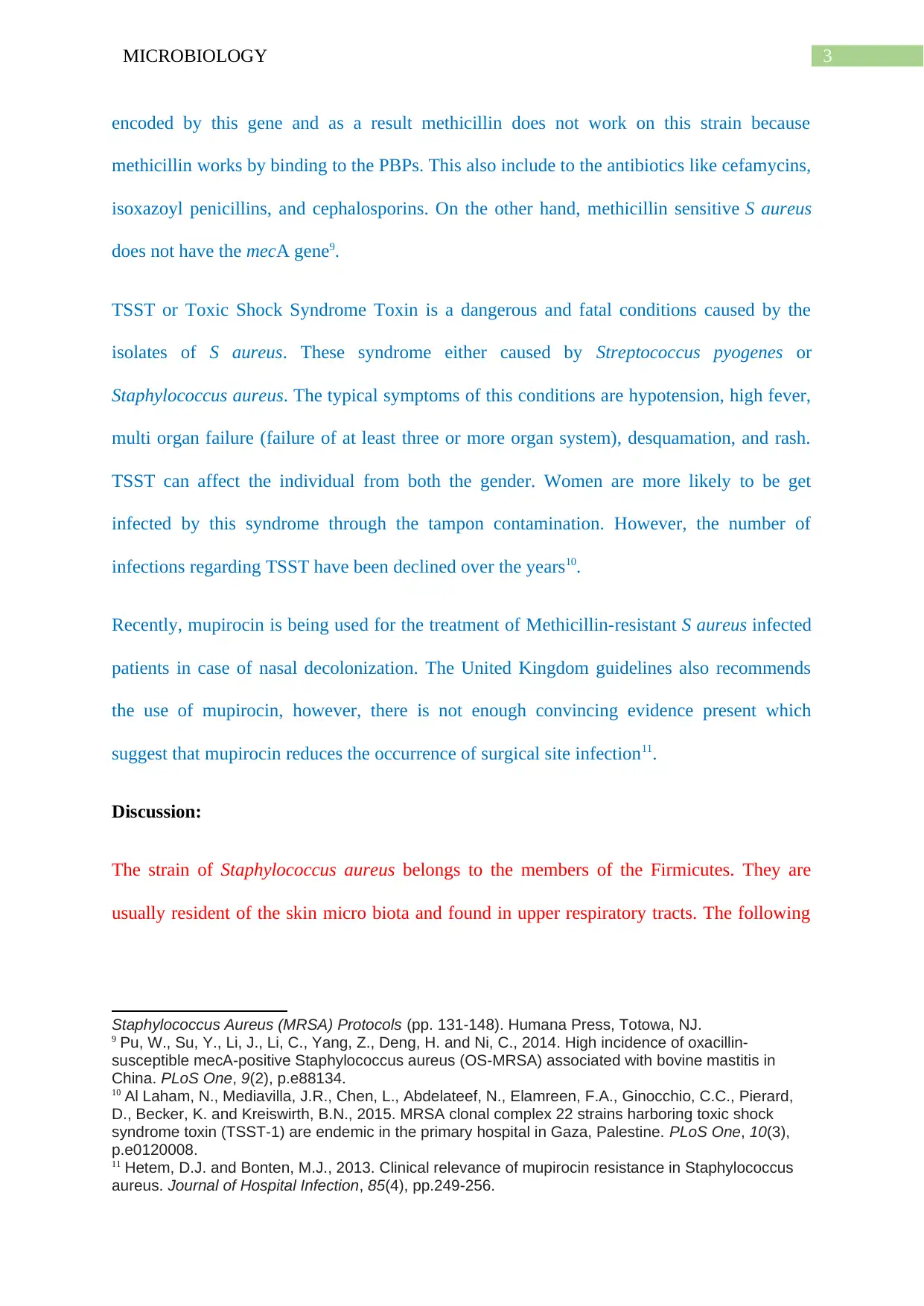
3MICROBIOLOGY
encoded by this gene and as a result methicillin does not work on this strain because
methicillin works by binding to the PBPs. This also include to the antibiotics like cefamycins,
isoxazoyl penicillins, and cephalosporins. On the other hand, methicillin sensitive S aureus
does not have the mecA gene9.
TSST or Toxic Shock Syndrome Toxin is a dangerous and fatal conditions caused by the
isolates of S aureus. These syndrome either caused by Streptococcus pyogenes or
Staphylococcus aureus. The typical symptoms of this conditions are hypotension, high fever,
multi organ failure (failure of at least three or more organ system), desquamation, and rash.
TSST can affect the individual from both the gender. Women are more likely to be get
infected by this syndrome through the tampon contamination. However, the number of
infections regarding TSST have been declined over the years10.
Recently, mupirocin is being used for the treatment of Methicillin-resistant S aureus infected
patients in case of nasal decolonization. The United Kingdom guidelines also recommends
the use of mupirocin, however, there is not enough convincing evidence present which
suggest that mupirocin reduces the occurrence of surgical site infection11.
Discussion:
The strain of Staphylococcus aureus belongs to the members of the Firmicutes. They are
usually resident of the skin micro biota and found in upper respiratory tracts. The following
Staphylococcus Aureus (MRSA) Protocols (pp. 131-148). Humana Press, Totowa, NJ.
9 Pu, W., Su, Y., Li, J., Li, C., Yang, Z., Deng, H. and Ni, C., 2014. High incidence of oxacillin-
susceptible mecA-positive Staphylococcus aureus (OS-MRSA) associated with bovine mastitis in
China. PLoS One, 9(2), p.e88134.
10 Al Laham, N., Mediavilla, J.R., Chen, L., Abdelateef, N., Elamreen, F.A., Ginocchio, C.C., Pierard,
D., Becker, K. and Kreiswirth, B.N., 2015. MRSA clonal complex 22 strains harboring toxic shock
syndrome toxin (TSST-1) are endemic in the primary hospital in Gaza, Palestine. PLoS One, 10(3),
p.e0120008.
11 Hetem, D.J. and Bonten, M.J., 2013. Clinical relevance of mupirocin resistance in Staphylococcus
aureus. Journal of Hospital Infection, 85(4), pp.249-256.
encoded by this gene and as a result methicillin does not work on this strain because
methicillin works by binding to the PBPs. This also include to the antibiotics like cefamycins,
isoxazoyl penicillins, and cephalosporins. On the other hand, methicillin sensitive S aureus
does not have the mecA gene9.
TSST or Toxic Shock Syndrome Toxin is a dangerous and fatal conditions caused by the
isolates of S aureus. These syndrome either caused by Streptococcus pyogenes or
Staphylococcus aureus. The typical symptoms of this conditions are hypotension, high fever,
multi organ failure (failure of at least three or more organ system), desquamation, and rash.
TSST can affect the individual from both the gender. Women are more likely to be get
infected by this syndrome through the tampon contamination. However, the number of
infections regarding TSST have been declined over the years10.
Recently, mupirocin is being used for the treatment of Methicillin-resistant S aureus infected
patients in case of nasal decolonization. The United Kingdom guidelines also recommends
the use of mupirocin, however, there is not enough convincing evidence present which
suggest that mupirocin reduces the occurrence of surgical site infection11.
Discussion:
The strain of Staphylococcus aureus belongs to the members of the Firmicutes. They are
usually resident of the skin micro biota and found in upper respiratory tracts. The following
Staphylococcus Aureus (MRSA) Protocols (pp. 131-148). Humana Press, Totowa, NJ.
9 Pu, W., Su, Y., Li, J., Li, C., Yang, Z., Deng, H. and Ni, C., 2014. High incidence of oxacillin-
susceptible mecA-positive Staphylococcus aureus (OS-MRSA) associated with bovine mastitis in
China. PLoS One, 9(2), p.e88134.
10 Al Laham, N., Mediavilla, J.R., Chen, L., Abdelateef, N., Elamreen, F.A., Ginocchio, C.C., Pierard,
D., Becker, K. and Kreiswirth, B.N., 2015. MRSA clonal complex 22 strains harboring toxic shock
syndrome toxin (TSST-1) are endemic in the primary hospital in Gaza, Palestine. PLoS One, 10(3),
p.e0120008.
11 Hetem, D.J. and Bonten, M.J., 2013. Clinical relevance of mupirocin resistance in Staphylococcus
aureus. Journal of Hospital Infection, 85(4), pp.249-256.
Paraphrase This Document
Need a fresh take? Get an instant paraphrase of this document with our AI Paraphraser
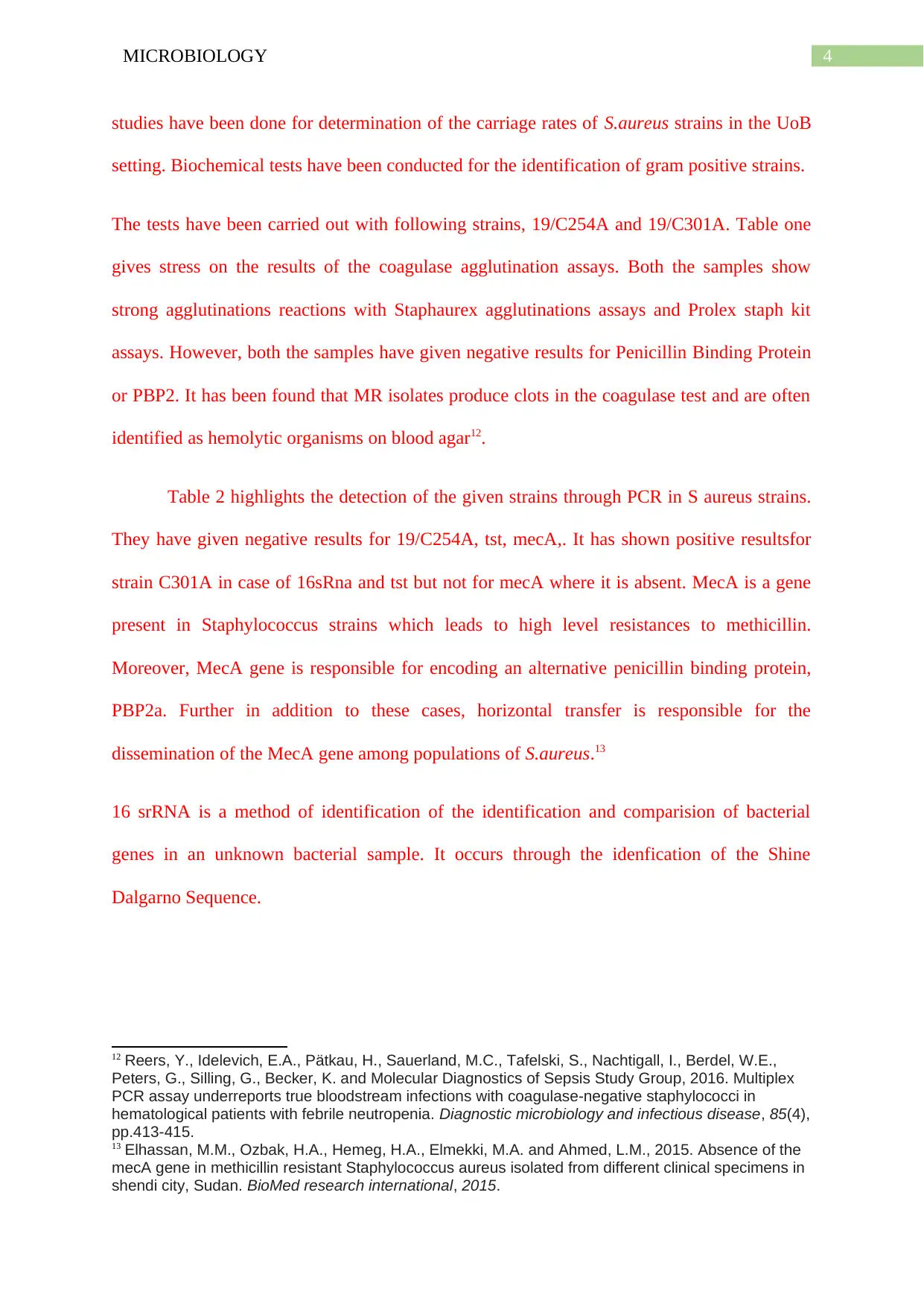
4MICROBIOLOGY
studies have been done for determination of the carriage rates of S.aureus strains in the UoB
setting. Biochemical tests have been conducted for the identification of gram positive strains.
The tests have been carried out with following strains, 19/C254A and 19/C301A. Table one
gives stress on the results of the coagulase agglutination assays. Both the samples show
strong agglutinations reactions with Staphaurex agglutinations assays and Prolex staph kit
assays. However, both the samples have given negative results for Penicillin Binding Protein
or PBP2. It has been found that MR isolates produce clots in the coagulase test and are often
identified as hemolytic organisms on blood agar12.
Table 2 highlights the detection of the given strains through PCR in S aureus strains.
They have given negative results for 19/C254A, tst, mecA,. It has shown positive resultsfor
strain C301A in case of 16sRna and tst but not for mecA where it is absent. MecA is a gene
present in Staphylococcus strains which leads to high level resistances to methicillin.
Moreover, MecA gene is responsible for encoding an alternative penicillin binding protein,
PBP2a. Further in addition to these cases, horizontal transfer is responsible for the
dissemination of the MecA gene among populations of S.aureus.13
16 srRNA is a method of identification of the identification and comparision of bacterial
genes in an unknown bacterial sample. It occurs through the idenfication of the Shine
Dalgarno Sequence.
12 Reers, Y., Idelevich, E.A., Pätkau, H., Sauerland, M.C., Tafelski, S., Nachtigall, I., Berdel, W.E.,
Peters, G., Silling, G., Becker, K. and Molecular Diagnostics of Sepsis Study Group, 2016. Multiplex
PCR assay underreports true bloodstream infections with coagulase-negative staphylococci in
hematological patients with febrile neutropenia. Diagnostic microbiology and infectious disease, 85(4),
pp.413-415.
13 Elhassan, M.M., Ozbak, H.A., Hemeg, H.A., Elmekki, M.A. and Ahmed, L.M., 2015. Absence of the
mecA gene in methicillin resistant Staphylococcus aureus isolated from different clinical specimens in
shendi city, Sudan. BioMed research international, 2015.
studies have been done for determination of the carriage rates of S.aureus strains in the UoB
setting. Biochemical tests have been conducted for the identification of gram positive strains.
The tests have been carried out with following strains, 19/C254A and 19/C301A. Table one
gives stress on the results of the coagulase agglutination assays. Both the samples show
strong agglutinations reactions with Staphaurex agglutinations assays and Prolex staph kit
assays. However, both the samples have given negative results for Penicillin Binding Protein
or PBP2. It has been found that MR isolates produce clots in the coagulase test and are often
identified as hemolytic organisms on blood agar12.
Table 2 highlights the detection of the given strains through PCR in S aureus strains.
They have given negative results for 19/C254A, tst, mecA,. It has shown positive resultsfor
strain C301A in case of 16sRna and tst but not for mecA where it is absent. MecA is a gene
present in Staphylococcus strains which leads to high level resistances to methicillin.
Moreover, MecA gene is responsible for encoding an alternative penicillin binding protein,
PBP2a. Further in addition to these cases, horizontal transfer is responsible for the
dissemination of the MecA gene among populations of S.aureus.13
16 srRNA is a method of identification of the identification and comparision of bacterial
genes in an unknown bacterial sample. It occurs through the idenfication of the Shine
Dalgarno Sequence.
12 Reers, Y., Idelevich, E.A., Pätkau, H., Sauerland, M.C., Tafelski, S., Nachtigall, I., Berdel, W.E.,
Peters, G., Silling, G., Becker, K. and Molecular Diagnostics of Sepsis Study Group, 2016. Multiplex
PCR assay underreports true bloodstream infections with coagulase-negative staphylococci in
hematological patients with febrile neutropenia. Diagnostic microbiology and infectious disease, 85(4),
pp.413-415.
13 Elhassan, M.M., Ozbak, H.A., Hemeg, H.A., Elmekki, M.A. and Ahmed, L.M., 2015. Absence of the
mecA gene in methicillin resistant Staphylococcus aureus isolated from different clinical specimens in
shendi city, Sudan. BioMed research international, 2015.
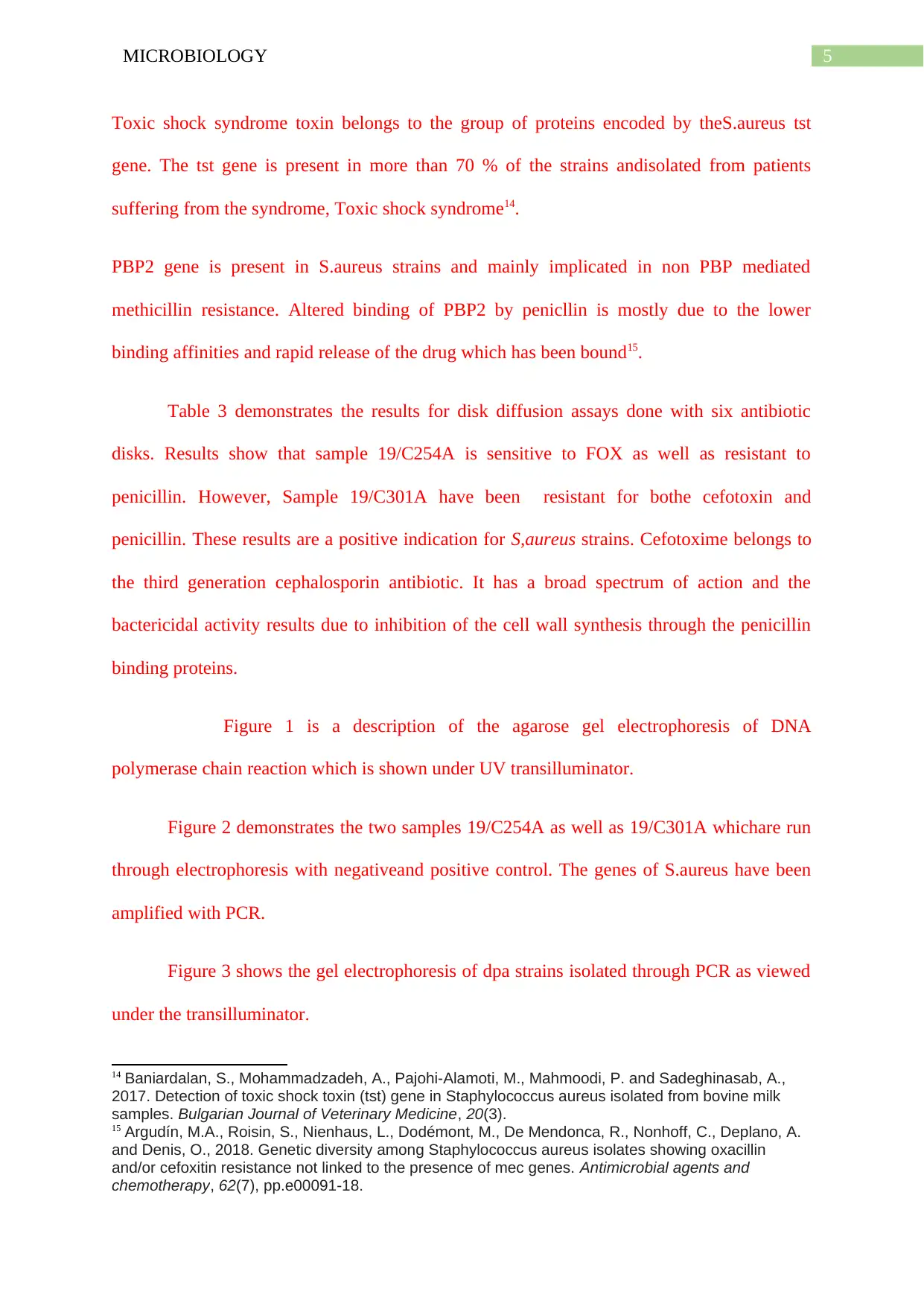
5MICROBIOLOGY
Toxic shock syndrome toxin belongs to the group of proteins encoded by theS.aureus tst
gene. The tst gene is present in more than 70 % of the strains andisolated from patients
suffering from the syndrome, Toxic shock syndrome14.
PBP2 gene is present in S.aureus strains and mainly implicated in non PBP mediated
methicillin resistance. Altered binding of PBP2 by penicllin is mostly due to the lower
binding affinities and rapid release of the drug which has been bound15.
Table 3 demonstrates the results for disk diffusion assays done with six antibiotic
disks. Results show that sample 19/C254A is sensitive to FOX as well as resistant to
penicillin. However, Sample 19/C301A have been resistant for bothe cefotoxin and
penicillin. These results are a positive indication for S,aureus strains. Cefotoxime belongs to
the third generation cephalosporin antibiotic. It has a broad spectrum of action and the
bactericidal activity results due to inhibition of the cell wall synthesis through the penicillin
binding proteins.
Figure 1 is a description of the agarose gel electrophoresis of DNA
polymerase chain reaction which is shown under UV transilluminator.
Figure 2 demonstrates the two samples 19/C254A as well as 19/C301A whichare run
through electrophoresis with negativeand positive control. The genes of S.aureus have been
amplified with PCR.
Figure 3 shows the gel electrophoresis of dpa strains isolated through PCR as viewed
under the transilluminator.
14 Baniardalan, S., Mohammadzadeh, A., Pajohi-Alamoti, M., Mahmoodi, P. and Sadeghinasab, A.,
2017. Detection of toxic shock toxin (tst) gene in Staphylococcus aureus isolated from bovine milk
samples. Bulgarian Journal of Veterinary Medicine, 20(3).
15 Argudín, M.A., Roisin, S., Nienhaus, L., Dodémont, M., De Mendonca, R., Nonhoff, C., Deplano, A.
and Denis, O., 2018. Genetic diversity among Staphylococcus aureus isolates showing oxacillin
and/or cefoxitin resistance not linked to the presence of mec genes. Antimicrobial agents and
chemotherapy, 62(7), pp.e00091-18.
Toxic shock syndrome toxin belongs to the group of proteins encoded by theS.aureus tst
gene. The tst gene is present in more than 70 % of the strains andisolated from patients
suffering from the syndrome, Toxic shock syndrome14.
PBP2 gene is present in S.aureus strains and mainly implicated in non PBP mediated
methicillin resistance. Altered binding of PBP2 by penicllin is mostly due to the lower
binding affinities and rapid release of the drug which has been bound15.
Table 3 demonstrates the results for disk diffusion assays done with six antibiotic
disks. Results show that sample 19/C254A is sensitive to FOX as well as resistant to
penicillin. However, Sample 19/C301A have been resistant for bothe cefotoxin and
penicillin. These results are a positive indication for S,aureus strains. Cefotoxime belongs to
the third generation cephalosporin antibiotic. It has a broad spectrum of action and the
bactericidal activity results due to inhibition of the cell wall synthesis through the penicillin
binding proteins.
Figure 1 is a description of the agarose gel electrophoresis of DNA
polymerase chain reaction which is shown under UV transilluminator.
Figure 2 demonstrates the two samples 19/C254A as well as 19/C301A whichare run
through electrophoresis with negativeand positive control. The genes of S.aureus have been
amplified with PCR.
Figure 3 shows the gel electrophoresis of dpa strains isolated through PCR as viewed
under the transilluminator.
14 Baniardalan, S., Mohammadzadeh, A., Pajohi-Alamoti, M., Mahmoodi, P. and Sadeghinasab, A.,
2017. Detection of toxic shock toxin (tst) gene in Staphylococcus aureus isolated from bovine milk
samples. Bulgarian Journal of Veterinary Medicine, 20(3).
15 Argudín, M.A., Roisin, S., Nienhaus, L., Dodémont, M., De Mendonca, R., Nonhoff, C., Deplano, A.
and Denis, O., 2018. Genetic diversity among Staphylococcus aureus isolates showing oxacillin
and/or cefoxitin resistance not linked to the presence of mec genes. Antimicrobial agents and
chemotherapy, 62(7), pp.e00091-18.
⊘ This is a preview!⊘
Do you want full access?
Subscribe today to unlock all pages.

Trusted by 1+ million students worldwide

6MICROBIOLOGY
Table 4 is a representation of the isolates received at the university S.aureus, MRSA,
MSSA, mecA, TST and spa type. Figure 4 is the pie chart representation of the same
information.
Conclusion
From the following biochemical and molecular tests done for the identification of the strains
of S.aureus it has been found that various isolates are still present in the setting. The pie chart
further highlights the prevalence of the strains and the isolates found in the university setting
Thus it can be concluded that S.aureus strain still pose a threat to the existing population of
the university of Bedfordshire.
Table 4 is a representation of the isolates received at the university S.aureus, MRSA,
MSSA, mecA, TST and spa type. Figure 4 is the pie chart representation of the same
information.
Conclusion
From the following biochemical and molecular tests done for the identification of the strains
of S.aureus it has been found that various isolates are still present in the setting. The pie chart
further highlights the prevalence of the strains and the isolates found in the university setting
Thus it can be concluded that S.aureus strain still pose a threat to the existing population of
the university of Bedfordshire.
Paraphrase This Document
Need a fresh take? Get an instant paraphrase of this document with our AI Paraphraser
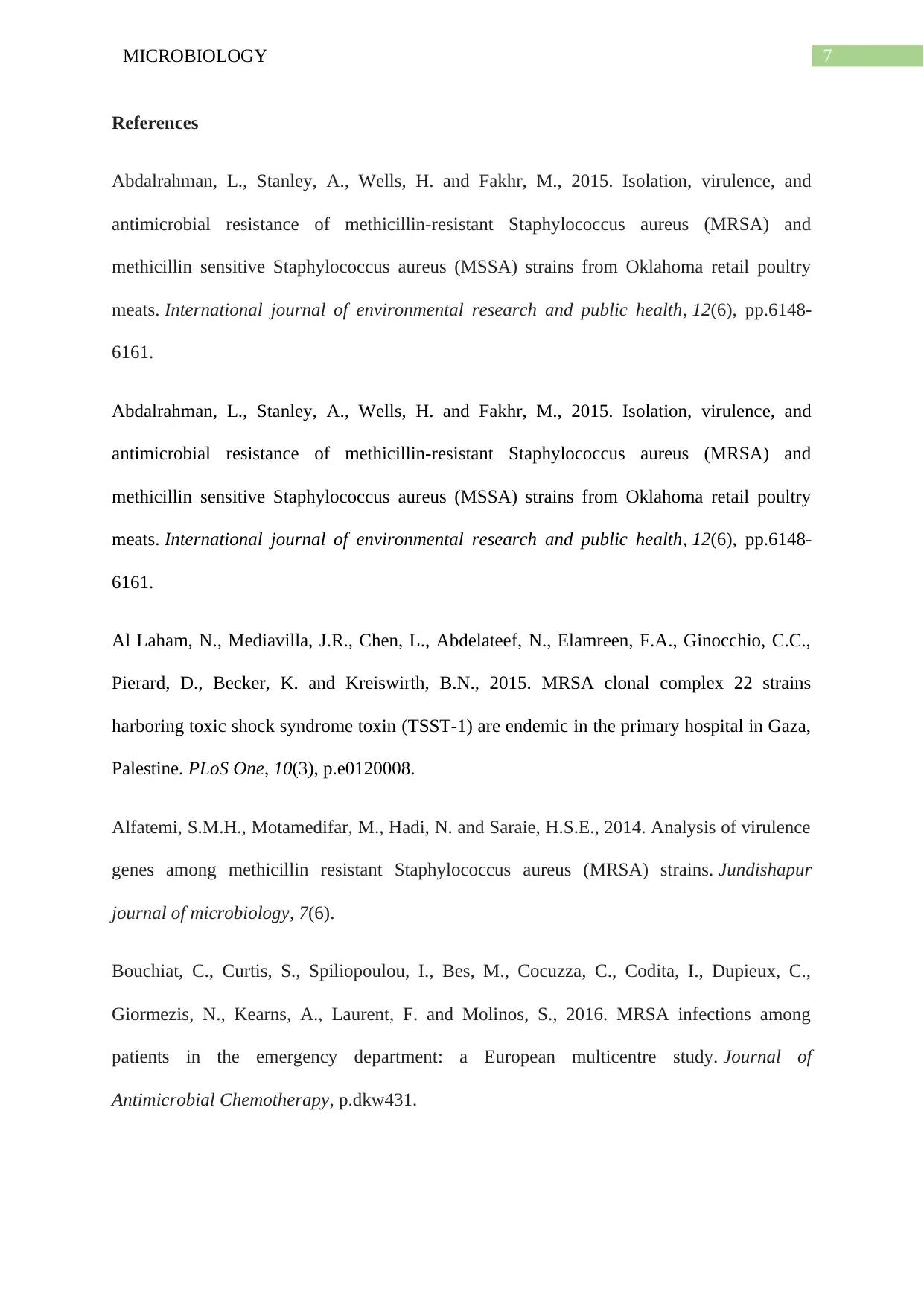
7MICROBIOLOGY
References
Abdalrahman, L., Stanley, A., Wells, H. and Fakhr, M., 2015. Isolation, virulence, and
antimicrobial resistance of methicillin-resistant Staphylococcus aureus (MRSA) and
methicillin sensitive Staphylococcus aureus (MSSA) strains from Oklahoma retail poultry
meats. International journal of environmental research and public health, 12(6), pp.6148-
6161.
Abdalrahman, L., Stanley, A., Wells, H. and Fakhr, M., 2015. Isolation, virulence, and
antimicrobial resistance of methicillin-resistant Staphylococcus aureus (MRSA) and
methicillin sensitive Staphylococcus aureus (MSSA) strains from Oklahoma retail poultry
meats. International journal of environmental research and public health, 12(6), pp.6148-
6161.
Al Laham, N., Mediavilla, J.R., Chen, L., Abdelateef, N., Elamreen, F.A., Ginocchio, C.C.,
Pierard, D., Becker, K. and Kreiswirth, B.N., 2015. MRSA clonal complex 22 strains
harboring toxic shock syndrome toxin (TSST-1) are endemic in the primary hospital in Gaza,
Palestine. PLoS One, 10(3), p.e0120008.
Alfatemi, S.M.H., Motamedifar, M., Hadi, N. and Saraie, H.S.E., 2014. Analysis of virulence
genes among methicillin resistant Staphylococcus aureus (MRSA) strains. Jundishapur
journal of microbiology, 7(6).
Bouchiat, C., Curtis, S., Spiliopoulou, I., Bes, M., Cocuzza, C., Codita, I., Dupieux, C.,
Giormezis, N., Kearns, A., Laurent, F. and Molinos, S., 2016. MRSA infections among
patients in the emergency department: a European multicentre study. Journal of
Antimicrobial Chemotherapy, p.dkw431.
References
Abdalrahman, L., Stanley, A., Wells, H. and Fakhr, M., 2015. Isolation, virulence, and
antimicrobial resistance of methicillin-resistant Staphylococcus aureus (MRSA) and
methicillin sensitive Staphylococcus aureus (MSSA) strains from Oklahoma retail poultry
meats. International journal of environmental research and public health, 12(6), pp.6148-
6161.
Abdalrahman, L., Stanley, A., Wells, H. and Fakhr, M., 2015. Isolation, virulence, and
antimicrobial resistance of methicillin-resistant Staphylococcus aureus (MRSA) and
methicillin sensitive Staphylococcus aureus (MSSA) strains from Oklahoma retail poultry
meats. International journal of environmental research and public health, 12(6), pp.6148-
6161.
Al Laham, N., Mediavilla, J.R., Chen, L., Abdelateef, N., Elamreen, F.A., Ginocchio, C.C.,
Pierard, D., Becker, K. and Kreiswirth, B.N., 2015. MRSA clonal complex 22 strains
harboring toxic shock syndrome toxin (TSST-1) are endemic in the primary hospital in Gaza,
Palestine. PLoS One, 10(3), p.e0120008.
Alfatemi, S.M.H., Motamedifar, M., Hadi, N. and Saraie, H.S.E., 2014. Analysis of virulence
genes among methicillin resistant Staphylococcus aureus (MRSA) strains. Jundishapur
journal of microbiology, 7(6).
Bouchiat, C., Curtis, S., Spiliopoulou, I., Bes, M., Cocuzza, C., Codita, I., Dupieux, C.,
Giormezis, N., Kearns, A., Laurent, F. and Molinos, S., 2016. MRSA infections among
patients in the emergency department: a European multicentre study. Journal of
Antimicrobial Chemotherapy, p.dkw431.
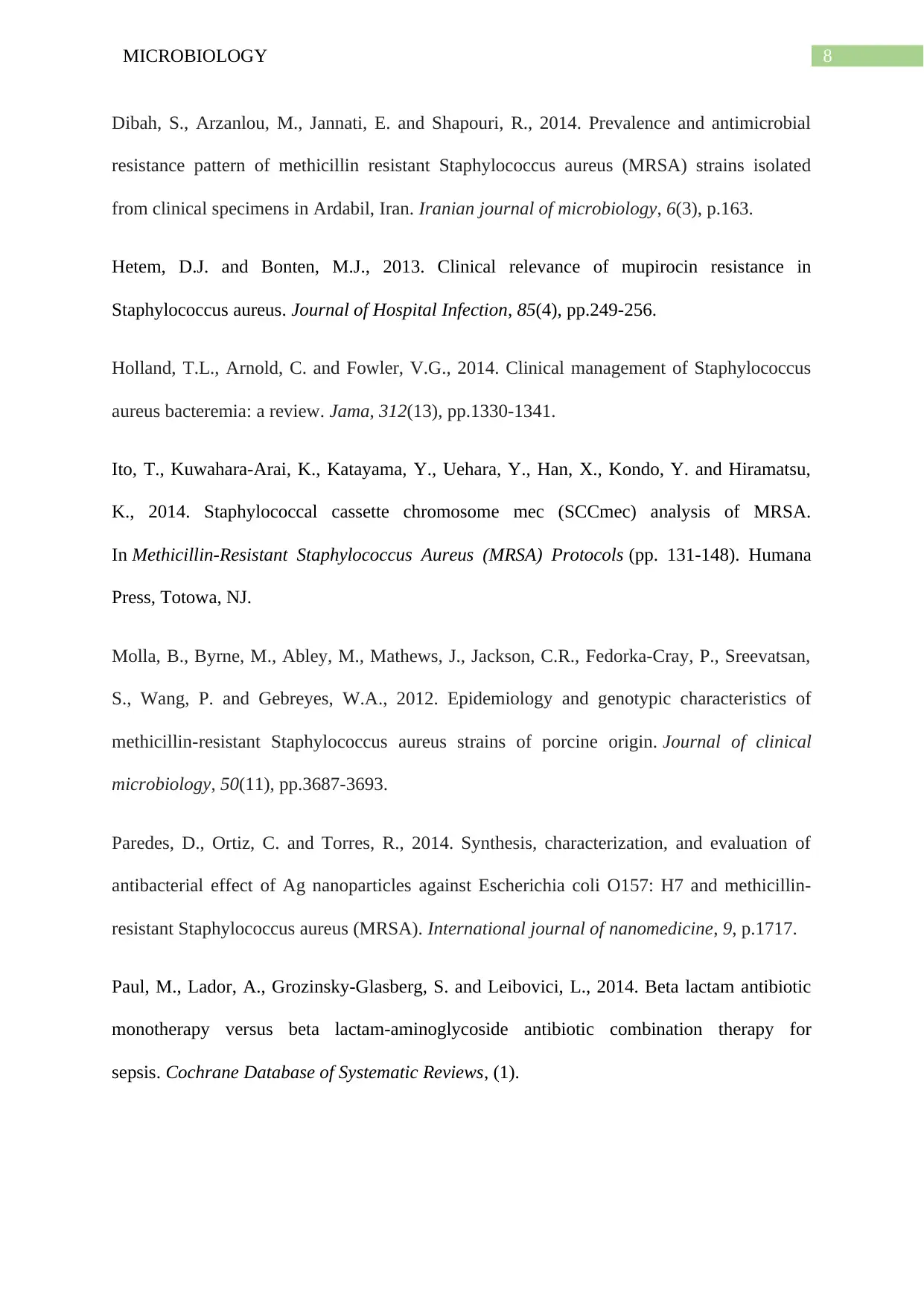
8MICROBIOLOGY
Dibah, S., Arzanlou, M., Jannati, E. and Shapouri, R., 2014. Prevalence and antimicrobial
resistance pattern of methicillin resistant Staphylococcus aureus (MRSA) strains isolated
from clinical specimens in Ardabil, Iran. Iranian journal of microbiology, 6(3), p.163.
Hetem, D.J. and Bonten, M.J., 2013. Clinical relevance of mupirocin resistance in
Staphylococcus aureus. Journal of Hospital Infection, 85(4), pp.249-256.
Holland, T.L., Arnold, C. and Fowler, V.G., 2014. Clinical management of Staphylococcus
aureus bacteremia: a review. Jama, 312(13), pp.1330-1341.
Ito, T., Kuwahara-Arai, K., Katayama, Y., Uehara, Y., Han, X., Kondo, Y. and Hiramatsu,
K., 2014. Staphylococcal cassette chromosome mec (SCCmec) analysis of MRSA.
In Methicillin-Resistant Staphylococcus Aureus (MRSA) Protocols (pp. 131-148). Humana
Press, Totowa, NJ.
Molla, B., Byrne, M., Abley, M., Mathews, J., Jackson, C.R., Fedorka-Cray, P., Sreevatsan,
S., Wang, P. and Gebreyes, W.A., 2012. Epidemiology and genotypic characteristics of
methicillin-resistant Staphylococcus aureus strains of porcine origin. Journal of clinical
microbiology, 50(11), pp.3687-3693.
Paredes, D., Ortiz, C. and Torres, R., 2014. Synthesis, characterization, and evaluation of
antibacterial effect of Ag nanoparticles against Escherichia coli O157: H7 and methicillin-
resistant Staphylococcus aureus (MRSA). International journal of nanomedicine, 9, p.1717.
Paul, M., Lador, A., Grozinsky‐Glasberg, S. and Leibovici, L., 2014. Beta lactam antibiotic
monotherapy versus beta lactam‐aminoglycoside antibiotic combination therapy for
sepsis. Cochrane Database of Systematic Reviews, (1).
Dibah, S., Arzanlou, M., Jannati, E. and Shapouri, R., 2014. Prevalence and antimicrobial
resistance pattern of methicillin resistant Staphylococcus aureus (MRSA) strains isolated
from clinical specimens in Ardabil, Iran. Iranian journal of microbiology, 6(3), p.163.
Hetem, D.J. and Bonten, M.J., 2013. Clinical relevance of mupirocin resistance in
Staphylococcus aureus. Journal of Hospital Infection, 85(4), pp.249-256.
Holland, T.L., Arnold, C. and Fowler, V.G., 2014. Clinical management of Staphylococcus
aureus bacteremia: a review. Jama, 312(13), pp.1330-1341.
Ito, T., Kuwahara-Arai, K., Katayama, Y., Uehara, Y., Han, X., Kondo, Y. and Hiramatsu,
K., 2014. Staphylococcal cassette chromosome mec (SCCmec) analysis of MRSA.
In Methicillin-Resistant Staphylococcus Aureus (MRSA) Protocols (pp. 131-148). Humana
Press, Totowa, NJ.
Molla, B., Byrne, M., Abley, M., Mathews, J., Jackson, C.R., Fedorka-Cray, P., Sreevatsan,
S., Wang, P. and Gebreyes, W.A., 2012. Epidemiology and genotypic characteristics of
methicillin-resistant Staphylococcus aureus strains of porcine origin. Journal of clinical
microbiology, 50(11), pp.3687-3693.
Paredes, D., Ortiz, C. and Torres, R., 2014. Synthesis, characterization, and evaluation of
antibacterial effect of Ag nanoparticles against Escherichia coli O157: H7 and methicillin-
resistant Staphylococcus aureus (MRSA). International journal of nanomedicine, 9, p.1717.
Paul, M., Lador, A., Grozinsky‐Glasberg, S. and Leibovici, L., 2014. Beta lactam antibiotic
monotherapy versus beta lactam‐aminoglycoside antibiotic combination therapy for
sepsis. Cochrane Database of Systematic Reviews, (1).
⊘ This is a preview!⊘
Do you want full access?
Subscribe today to unlock all pages.

Trusted by 1+ million students worldwide
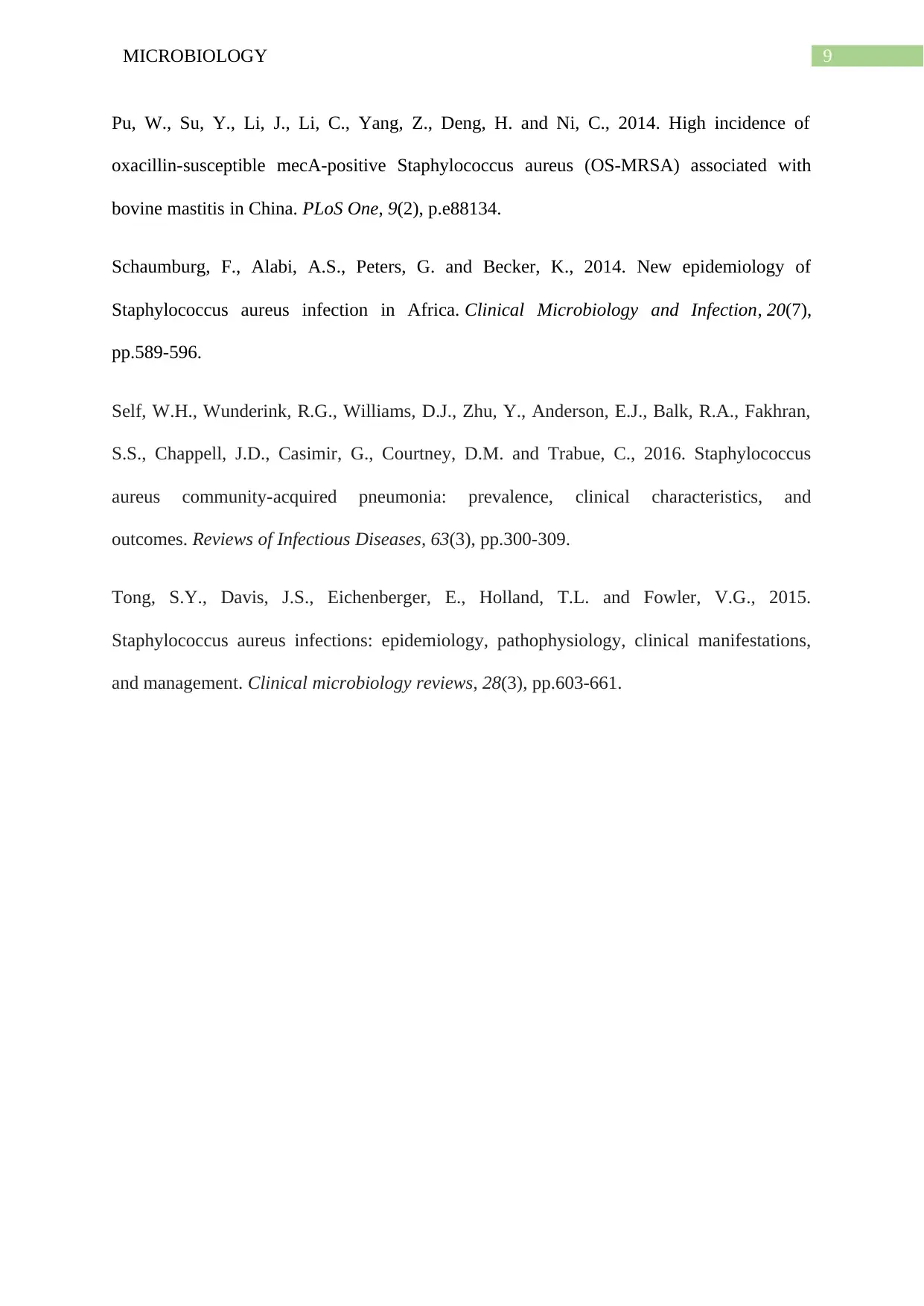
9MICROBIOLOGY
Pu, W., Su, Y., Li, J., Li, C., Yang, Z., Deng, H. and Ni, C., 2014. High incidence of
oxacillin-susceptible mecA-positive Staphylococcus aureus (OS-MRSA) associated with
bovine mastitis in China. PLoS One, 9(2), p.e88134.
Schaumburg, F., Alabi, A.S., Peters, G. and Becker, K., 2014. New epidemiology of
Staphylococcus aureus infection in Africa. Clinical Microbiology and Infection, 20(7),
pp.589-596.
Self, W.H., Wunderink, R.G., Williams, D.J., Zhu, Y., Anderson, E.J., Balk, R.A., Fakhran,
S.S., Chappell, J.D., Casimir, G., Courtney, D.M. and Trabue, C., 2016. Staphylococcus
aureus community-acquired pneumonia: prevalence, clinical characteristics, and
outcomes. Reviews of Infectious Diseases, 63(3), pp.300-309.
Tong, S.Y., Davis, J.S., Eichenberger, E., Holland, T.L. and Fowler, V.G., 2015.
Staphylococcus aureus infections: epidemiology, pathophysiology, clinical manifestations,
and management. Clinical microbiology reviews, 28(3), pp.603-661.
Pu, W., Su, Y., Li, J., Li, C., Yang, Z., Deng, H. and Ni, C., 2014. High incidence of
oxacillin-susceptible mecA-positive Staphylococcus aureus (OS-MRSA) associated with
bovine mastitis in China. PLoS One, 9(2), p.e88134.
Schaumburg, F., Alabi, A.S., Peters, G. and Becker, K., 2014. New epidemiology of
Staphylococcus aureus infection in Africa. Clinical Microbiology and Infection, 20(7),
pp.589-596.
Self, W.H., Wunderink, R.G., Williams, D.J., Zhu, Y., Anderson, E.J., Balk, R.A., Fakhran,
S.S., Chappell, J.D., Casimir, G., Courtney, D.M. and Trabue, C., 2016. Staphylococcus
aureus community-acquired pneumonia: prevalence, clinical characteristics, and
outcomes. Reviews of Infectious Diseases, 63(3), pp.300-309.
Tong, S.Y., Davis, J.S., Eichenberger, E., Holland, T.L. and Fowler, V.G., 2015.
Staphylococcus aureus infections: epidemiology, pathophysiology, clinical manifestations,
and management. Clinical microbiology reviews, 28(3), pp.603-661.
1 out of 10
Related Documents
Your All-in-One AI-Powered Toolkit for Academic Success.
+13062052269
info@desklib.com
Available 24*7 on WhatsApp / Email
![[object Object]](/_next/static/media/star-bottom.7253800d.svg)
Unlock your academic potential
Copyright © 2020–2025 A2Z Services. All Rights Reserved. Developed and managed by ZUCOL.





